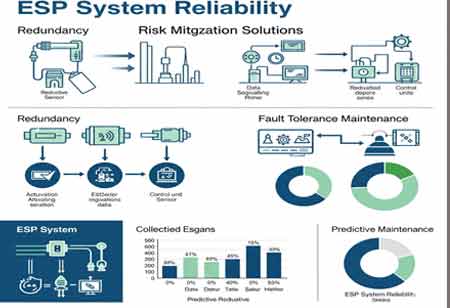Thank you for Subscribing to Energy Business Review Weekly Brief
Mitigating ESP Downtime Risk in Remote or Hostile Operating Regions
ESPs are vital for oil production but face risks in remote environments. Advances in materials, monitoring, and system redundancy enhance reliability and reduce downtime.

By
Energy Business Review | Tuesday, June 24, 2025
Stay ahead of the industry with exclusive feature stories on the top companies, expert insights and the latest news delivered straight to your inbox. Subscribe today.
Fremont, CA: Electric Submersible Pumps (ESPs) are the workhorses of artificial lift in oil and gas production, playing a crucial role in maintaining fluid flow, particularly in mature fields and challenging reservoirs. However, their operation in remote, geographically isolated, or hostile environments (e.g., high temperature, high pressure, corrosive fluids, high gas content, or deepwater/subsea installations) significantly amplifies the risk of downtime. Unplanned ESP failures in such locations result in substantial production losses, exorbitant intervention costs, and logistical challenges.
Latest Strategies for Downtime Mitigation
The choice of materials has a significant impact on the reliability of ESP operation in hostile environments. Recent advancements have placed a strong emphasis on the use of corrosion- and abrasion-resistant materials, such as ceramics and polymers, as well as advanced metallic grades. These materials play a crucial role in the design of high-reliability ESP systems, which are engineered for challenging conditions. They enable the incorporation of extreme-temperature materials, robust plug-and-play technology, enhanced sealing mechanisms, and improved motor and pump designs.
Enhanced monitoring and predictive analytics are crucial in remote operations, leveraging the Internet of Things (IoT) and Artificial Intelligence (AI). Real-time downhole and surface monitoring, SCADA systems, and the power of AI/ML-driven predictive maintenance enable remote decision-making and automated troubleshooting, empowering you to stay in control even in challenging conditions.
Building redundancy into ESP system design is critical to minimize the impact of component failures. Dual ESP systems (Y-Tool Systems) and modular, redundant components enable easier replacement and incorporate redundancy at the component level. Automated failover mechanisms in control systems ensure seamless switching to backup components or systems in the event of a primary component or system failure.
Proactive maintenance and operational optimization are not only beneficial but also essential for ensuring the integrity of ESP components. These practices, which include rigorous pre-deployment testing, optimized operating parameters, regular inspections and preventive maintenance, thorough personnel training, and contingency planning and spare parts management, are key to minimizing the impact of component failures.
The Future Landscape
The growing trend toward autonomous operations, coupled with the continued integration of artificial intelligence (AI), the Internet of Things (IoT), and digital twin technology, is poised to significantly enhance the reliability of ESPs in remote and challenging environments. Among the most impactful advancements are the emergence of self-healing systems—ESPs with high levels of autonomy capable of detecting and self-correcting minor anomalies without requiring human intervention. Digital twin technology is also gaining traction, enabling the creation of virtual replicas of ESP systems for real-time performance simulation, predictive failure modeling, and the safe optimization of operational strategies. Enhanced connectivity, driven by advancements in satellite communication and low-power wide-area networks (LPWAN), is poised to improve data transmission from even the most remote locations. The deployment of robotics and drones is expected to rise, supporting inspections and minor maintenance activities in hazardous or otherwise inaccessible areas, thereby minimizing human exposure to risk.
Mitigating ESP downtime risk in remote and hostile operating regions is a complex but increasingly critical challenge for the energy industry. By embracing the latest advancements in material science, predictive analytics, system redundancy, and proactive operational strategies, companies can significantly enhance ESP reliability, extend run life, reduce costly interventions, and ultimately ensure sustainable and profitable production even in the most demanding environments. The future of ESP operations in these challenging frontiers hinges on continued innovation and a holistic commitment to resilience.






